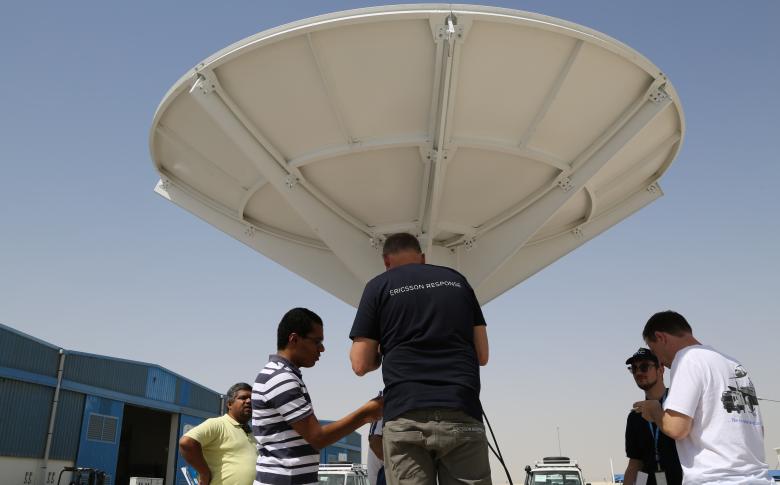ETC pilots new training for emergency responders

In the barely-tolerable heat of the blazing Dubai sun, 12 members of World Food Programme’s (WFP) IT emergency response capacity, the Fast IT and Telecommunications Emergency and Support Team (FITTEST), and Emergency Telecommunications Cluster (ETC) member Ericsson Response stood outside the WFP warehouses, patiently waiting for a pilot technical training to begin.
As the very first activity of the Crisis Connectivity Charter – a set of commitments agreed upon by world-leading satellite operators and integrators to enhance connectivity in humanitarian crises – that was signed last October, these participants were essentially guinea pigs, albeit very cooperative ones!
The satellite operator training was aimed at equipping ETC responders with the skills and experience needed to deploy and maintain the variety of satellite solutions facilitated through the Crisis Connectivity Charter, in humanitarian emergencies.
Martin Falebrand from Ericsson Response and a veteran ETC responder, said: “As a responder to emergencies, you often find yourself forced to use equipment you’ve never used before. This is a challenge and of course, not optimal. So to get the opportunity to do hands-on training in advance on systems you possibly will deploy in a future emergency one day is really good. It enables us to provide even better, faster services when it is critical.
“The fact that we got the full Global VSAT Forum (GVF) training and certification was also great. This means we will deliver as professionals.”
A FITTEST participant, Kaleem Mohammed, added: “The training was very well designed and was comprehensive. It included several classroom sessions followed by hands-on skills training.”
Combining classroom theory and best practices with getting their hands dirty in practical technical sessions was what made the pilot training a success. Participants were able to try out various solutions with equipment ranging from first onset, small terminals, up to three-metre wide satellite dishes for the later stages of an emergency and long-term use.
“It is nice to see how the technology is evolving,” said Martin “and that some of the equipment you can now configure by more or less pushing a single button in an app on your smartphone.”
At the end of the five days, participants had a final exam in order to pass the course. Not that this was a race, but Kaleem did point out that he was the first to complete all the tests and therefore the first to become certified as a GVF Advance Satcom Professional. “After the training, we were able to correctly assemble all the equipment kits, perform accurate pointing as well as perform basic troubleshooting and make configuration changes to suit a given site in the field,” added Kaleem.
With today’s world more in flux today than ever before, with conflicts raging across the Middle East, natural disasters erupting the world over and the refugee crisis currently rocking Europe, the ability to communicate is even more essential to ensure life-saving assistance is delivered to those who need it most. Developing and maintaining technical solutions underpins this lifesaving communication. Pilot projects like the satellite operator training that broadens the skill sets of emergency responders are ever more critical to future humanitarian support and response.
“The Ka-band terminal – easy to deploy, fairly small (1-metre dish) and with a very high bandwidth – will definitely be very effective to use in disaster-prone areas if and when there is coverage,” Martin explained.
“To have such a system that is easy to deploy and transport, gives the ETC the chance to deliver the services in many locations if there equipment and funding available, not only in a few selected sites. To have the satellite charter with the main providers globally backing up the ETC operations is very good. It definitely gives us the possibility to deliver our services to the humanitarian community and the affected population as outlined in the ETC2020 vision. I would even say it is impossible without.”
The Crisis Connectivity Charter was established by the EMEA Satellite Operators’ Association (ESOA) and the Global VSAT Forum (GVF) with the support of the United Nations World Food Programme (WFP)-led Emergency Telecommunications Cluster (ETC), and the UN Office for the Coordination of Humanitarian Affairs.
By Suzanne Fenton, IT Emergency Preparedness and Response Branch, WFP